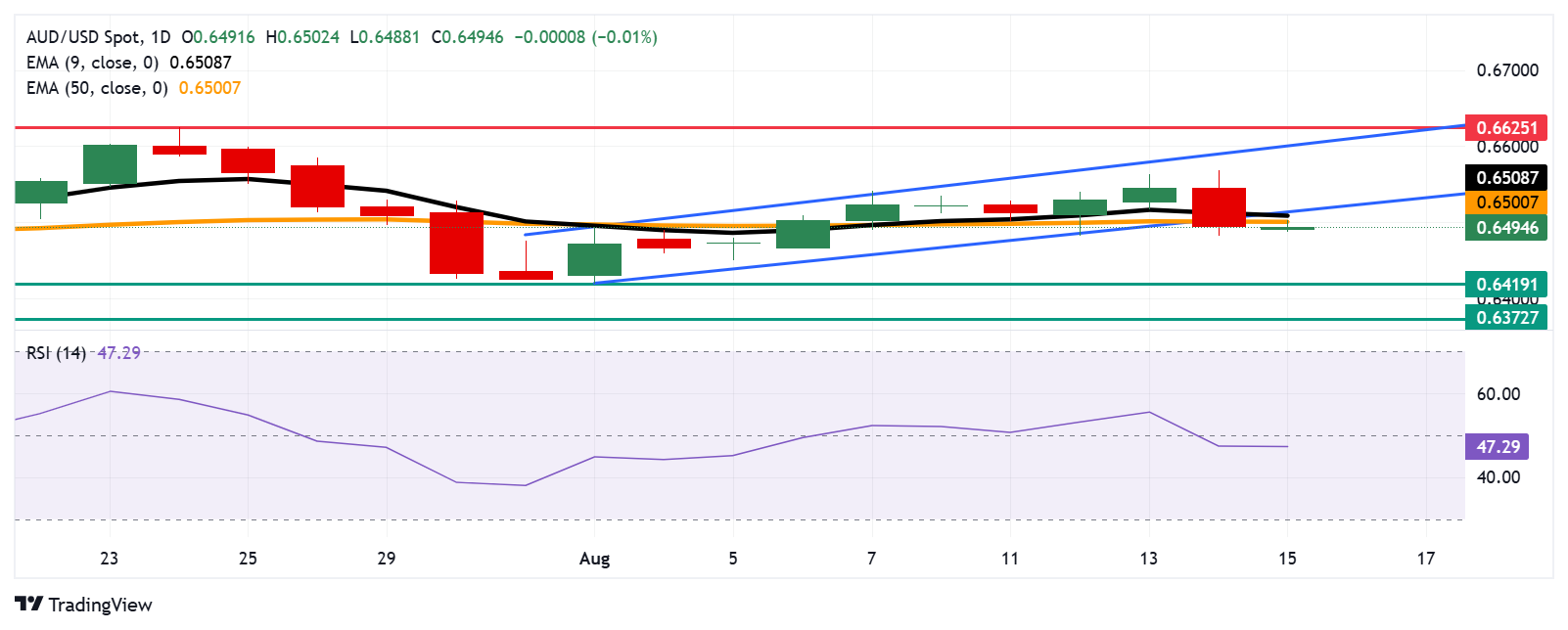- The Australian Dollar recovers ground despite disappointing economic data from China.
- China’s Retail Sales climbed 3.7% YoY in July, falling short of the 4.6% expected and 4.8% in June.
- The US Dollar edges lower after registering a nearly 0.5% gain in the previous session.
The Australian Dollar (AUD) appreciates against the US Dollar (USD) on Friday despite disappointing key economic data from China, Australia’s major trading partner. The AUD/USD lost more than 0.5% in the previous session as the US Dollar gained ground following stronger US economic data.
China’s Retail Sales rose 3.7% year-over-year in July, falling short of 4.6% expected and 4.8% in June. Meanwhile, Industrial Production increased 5.7% YoY, compared to the 5.9% forecast and 6.8% seen previously.
The downside of the AUD/USD pair could be limited as the US Dollar struggles amid rising expectations that the Federal Reserve (Fed) will cut rates in September. The US July Retail Sales data and the preliminary Michigan Consumer Sentiment Index will be eyed later in the day.
Australian Dollar advances as US Dollar edges lower ahead of Retail Sales data
- The US Dollar Index (DXY), which measures the value of the US Dollar against six major currencies, is losing ground and trading around 98.10 at the time of writing.
- The US Producer Price Index (PPI) rose 3.3% YoY in July, versus the 2.4% increase prior. This reading came in stronger than the expectations of 2.5% by a wide margin. The annual core PPI climbed 3.7% in July, compared to 2.6% in June and the 2.9% expected.
- US Initial Jobless Claims for the week ending August 9 fell to 224K versus 227K prior (revised from 226K). This figure was below the market consensus of 228K.
- CME’s FedWatch tool indicates that Fed funds futures traders are now pricing in nearly a 92% chance of a 25 basis point (bps) interest rate cut at the September meeting.
- US Treasury Secretary Scott Bessent said in an interview on Wednesday that short-term Fed interest rates should be 1.5-1.75% lower than the current benchmark rate at an effective 4.33%. Bessent added that there is a good chance the central bank could opt for a 50-basis-point rate cut in September.
- US President Donald Trump shared his “paper calculation” that Fed interest rates should be at or near 1%. Trump also noted interest rates should be three or four points lower. Interest rates are just a paper calculation, he added.
- Richmond Fed President Thomas Barkin stated on Thursday that a lot of companies are still not able to resume a strong pace of hiring despite an improved business sentiment. A constant cycle of ever-changing tariffs suppressed the mood of many business operators in the first and second quarters, driving down the pace of hiring.
- St. Louis Fed President Alberto Musalem told CNBC that tariffs are feeding through to inflation, which is running close to 3%. Musalem also said that “If the Fed were to weigh the labor market side more and reduce rates aggressively, that could lead to higher inflation expectations and be counterproductive.” “If the Fed were to weigh the labor market side more and reduce rates, that could lead to higher inflation expectations and be counterproductive,” he added.
- White House spokeswoman Karoline Leavitt said on Tuesday that US President Donald Trump is considering legal action against Fed Chair Jerome Powell over his handling of renovations at the central bank’s headquarters, raising concerns about the Fed’s independence, per Reuters.
- US Treasury Secretary Scott Bessent said on Wednesday that US and Chinese trade officials will meet again within the next two to three months to discuss the future of their economic ties. “The US would need to see sustained progress on curbing fentanyl flows from China, potentially over months or even a year, before considering tariff reductions,” Bessent said.
- Australia’s Employment Change arrived at 24.5K in July from 1K in June (revised from 2K), against the consensus forecast of 25K. Meanwhile, the Unemployment Rate fell to 4.2%, as expected, from 4.3% in June.
- The Reserve Bank of Australia (RBA) delivered a 25 basis points (bps) interest rate cut on Tuesday, as widely expected, bringing the Official Cash Rate (OCR) to 3.6% from 3.85% at the August policy meeting.
- RBA Governor Michele Bullock stated that current forecasts suggest the cash rate may need to be reduced to ensure price stability. However, Bullock emphasized the Board’s meeting-by-meeting approach and refrained from making any commitments on rate moves should financial markets experience a bout of volatility. The RBA’s monetary policy statement noted that inflation has continued to moderate. The outlook remains uncertain. It reaffirmed that maintaining price stability and full employment remains the top priority.
Australian Dollar rebounds toward confluence resistance zone near 0.6500
The AUD/USD pair is trading around 0.6490 on Friday. Technical analysis on the daily chart suggests a momentum shift from bullish to bearish bias as the pair has broken below the ascending channel pattern. The pair also moved below the nine-day Exponential Moving Average (EMA), signaling that short-term momentum is weaker. Moreover, the 14-day Relative Strength Index (RSI) is positioned below the 50 level, suggesting that market bias is bearish.
On the downside, as the short- and medium-term price momentum is dampened, the AUD/USD pair could navigate the region around the two-month low of 0.6419, recorded on August 1, followed by a three-month low at 0.6372, recorded on June 23.
The AUD/USD pair may target the immediate barrier at the 50-day EMA of 0.6500, followed by the nine-day EMA at 0.6508. A rebound toward the ascending channel would suggest a bearish trap and a bullish recovery.
AUD/USD: Daily Chart

Australian Dollar PRICE Today
The table below shows the percentage change of Australian Dollar (AUD) against listed major currencies today. Australian Dollar was the strongest against the US Dollar.
| USD | EUR | GBP | JPY | CAD | AUD | NZD | CHF | |
|---|---|---|---|---|---|---|---|---|
| USD | -0.22% | -0.16% | -0.54% | -0.15% | -0.25% | -0.12% | -0.16% | |
| EUR | 0.22% | 0.05% | -0.22% | 0.07% | -0.05% | 0.08% | 0.06% | |
| GBP | 0.16% | -0.05% | -0.28% | 0.02% | -0.10% | 0.03% | 0.01% | |
| JPY | 0.54% | 0.22% | 0.28% | 0.30% | 0.20% | 0.37% | 0.27% | |
| CAD | 0.15% | -0.07% | -0.02% | -0.30% | -0.05% | 0.01% | -0.01% | |
| AUD | 0.25% | 0.05% | 0.10% | -0.20% | 0.05% | 0.06% | 0.11% | |
| NZD | 0.12% | -0.08% | -0.03% | -0.37% | -0.01% | -0.06% | -0.02% | |
| CHF | 0.16% | -0.06% | -0.01% | -0.27% | 0.00% | -0.11% | 0.02% |
The heat map shows percentage changes of major currencies against each other. The base currency is picked from the left column, while the quote currency is picked from the top row. For example, if you pick the Australian Dollar from the left column and move along the horizontal line to the US Dollar, the percentage change displayed in the box will represent AUD (base)/USD (quote).
Australian Dollar FAQs
One of the most significant factors for the Australian Dollar (AUD) is the level of interest rates set by the Reserve Bank of Australia (RBA). Because Australia is a resource-rich country another key driver is the price of its biggest export, Iron Ore. The health of the Chinese economy, its largest trading partner, is a factor, as well as inflation in Australia, its growth rate and Trade Balance. Market sentiment – whether investors are taking on more risky assets (risk-on) or seeking safe-havens (risk-off) – is also a factor, with risk-on positive for AUD.
The Reserve Bank of Australia (RBA) influences the Australian Dollar (AUD) by setting the level of interest rates that Australian banks can lend to each other. This influences the level of interest rates in the economy as a whole. The main goal of the RBA is to maintain a stable inflation rate of 2-3% by adjusting interest rates up or down. Relatively high interest rates compared to other major central banks support the AUD, and the opposite for relatively low. The RBA can also use quantitative easing and tightening to influence credit conditions, with the former AUD-negative and the latter AUD-positive.
China is Australia’s largest trading partner so the health of the Chinese economy is a major influence on the value of the Australian Dollar (AUD). When the Chinese economy is doing well it purchases more raw materials, goods and services from Australia, lifting demand for the AUD, and pushing up its value. The opposite is the case when the Chinese economy is not growing as fast as expected. Positive or negative surprises in Chinese growth data, therefore, often have a direct impact on the Australian Dollar and its pairs.
Iron Ore is Australia’s largest export, accounting for $118 billion a year according to data from 2021, with China as its primary destination. The price of Iron Ore, therefore, can be a driver of the Australian Dollar. Generally, if the price of Iron Ore rises, AUD also goes up, as aggregate demand for the currency increases. The opposite is the case if the price of Iron Ore falls. Higher Iron Ore prices also tend to result in a greater likelihood of a positive Trade Balance for Australia, which is also positive of the AUD.
The Trade Balance, which is the difference between what a country earns from its exports versus what it pays for its imports, is another factor that can influence the value of the Australian Dollar. If Australia produces highly sought after exports, then its currency will gain in value purely from the surplus demand created from foreign buyers seeking to purchase its exports versus what it spends to purchase imports. Therefore, a positive net Trade Balance strengthens the AUD, with the opposite effect if the Trade Balance is negative.






